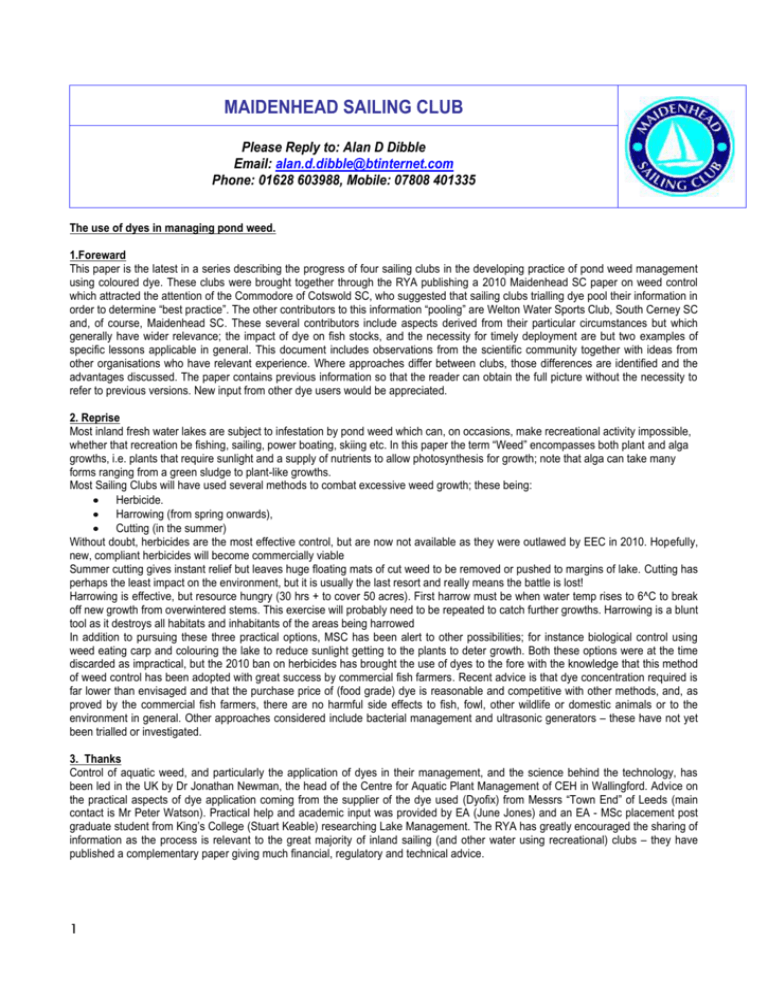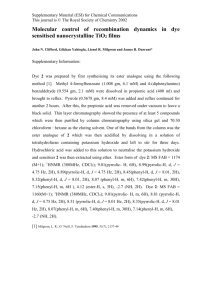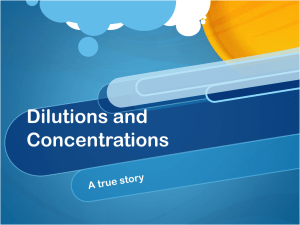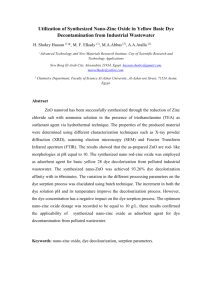The use of dyes in managing pond weed
advertisement

MAIDENHEAD SAILING CLUB Please Reply to: Alan D Dibble Email: alan.d.dibble@btinternet.com Phone: 01628 603988, Mobile: 07808 401335 The use of dyes in managing pond weed. 1.Foreward This paper is the latest in a series describing the progress of four sailing clubs in the developing practice of pond weed management using coloured dye. These clubs were brought together through the RYA publishing a 2010 Maidenhead SC paper on weed control which attracted the attention of the Commodore of Cotswold SC, who suggested that sailing clubs trialling dye pool their information in order to determine “best practice”. The other contributors to this information “pooling” are Welton Water Sports Club, South Cerney SC and, of course, Maidenhead SC. These several contributors include aspects derived from their particular circumstances but which generally have wider relevance; the impact of dye on fish stocks, and the necessity for timely deployment are but two examples of specific lessons applicable in general. This document includes observations from the scientific community together with ideas from other organisations who have relevant experience. Where approaches differ between clubs, those differences are identified and the advantages discussed. The paper contains previous information so that the reader can obtain the full picture without the necessity to refer to previous versions. New input from other dye users would be appreciated. 2. Reprise Most inland fresh water lakes are subject to infestation by pond weed which can, on occasions, make recreational activity impossible, whether that recreation be fishing, sailing, power boating, skiing etc. In this paper the term “Weed” encompasses both plant and alga growths, i.e. plants that require sunlight and a supply of nutrients to allow photosynthesis for growth; note that alga can take many forms ranging from a green sludge to plant-like growths. Most Sailing Clubs will have used several methods to combat excessive weed growth; these being: Herbicide. Harrowing (from spring onwards), Cutting (in the summer) Without doubt, herbicides are the most effective control, but are now not available as they were outlawed by EEC in 2010. Hopefully, new, compliant herbicides will become commercially viable Summer cutting gives instant relief but leaves huge floating mats of cut weed to be removed or pushed to margins of lake. Cutting has perhaps the least impact on the environment, but it is usually the last resort and really means the battle is lost! Harrowing is effective, but resource hungry (30 hrs + to cover 50 acres). First harrow must be when water temp rises to 6^C to break off new growth from overwintered stems. This exercise will probably need to be repeated to catch further growths. Harrowing is a blunt tool as it destroys all habitats and inhabitants of the areas being harrowed In addition to pursuing these three practical options, MSC has been alert to other possibilities; for instance biological control using weed eating carp and colouring the lake to reduce sunlight getting to the plants to deter growth. Both these options were at the time discarded as impractical, but the 2010 ban on herbicides has brought the use of dyes to the fore with the knowledge that this method of weed control has been adopted with great success by commercial fish farmers. Recent advice is that dye concentration required is far lower than envisaged and that the purchase price of (food grade) dye is reasonable and competitive with other methods, and, as proved by the commercial fish farmers, there are no harmful side effects to fish, fowl, other wildlife or domestic animals or to the environment in general. Other approaches considered include bacterial management and ultrasonic generators – these have not yet been trialled or investigated. 3. Thanks Control of aquatic weed, and particularly the application of dyes in their management, and the science behind the technology, has been led in the UK by Dr Jonathan Newman, the head of the Centre for Aquatic Plant Management of CEH in Wallingford. Advice on the practical aspects of dye application coming from the supplier of the dye used (Dyofix) from Messrs “Town End” of Leeds (main contact is Mr Peter Watson). Practical help and academic input was provided by EA (June Jones) and an EA - MSc placement post graduate student from King’s College (Stuart Keable) researching Lake Management. The RYA has greatly encouraged the sharing of information as the process is relevant to the great majority of inland sailing (and other water using recreational) clubs – they have published a complementary paper giving much financial, regulatory and technical advice. 1 4. Environmental Considerations. The water conditions and local environment faced by the collaborators are broadly similar, but the differences are important as they can have a direct effect on dye deployment and management constraints. In common with the collaborators, the great majority of clubs share their waters with a fishing syndicate and are welcoming to the bird watching community (the varied local environments ensures a wide number of species nesting or otherwise using the water). There will almost certainly be several mammal species inhabiting the margins. There will also be (generally unobserved) much invertebrate life on the bottom. Water management must therefore maintain the habitats for all these life forms and take account of the contribution that aquatic plants and alga make in creating a viable and balanced ecology. There are possible legal constraints to dye use; Maidenhead is connected to the groundwater system and is thus a “controlled water” and must not introduce any potential contaminants; other clubs have different constraints, Sites of Special Scientific Interest etc. All clubs must therefore attempt to create a balanced ecology where the sailing need for unobstructed waters is convergent with wider water environmental considerations. This balancing act is best achieved by using the minimum concentration of dye sufficient to control weed but with minimal impact on other aspects of the environment. Clearly, keeping dye concentration to the minimum also minimises the cost. The collaborators lakes are typically 50 acres, with the exception of Welton, which is double that size. Typical depth is 2.5 metres, apart from South Cerney which is about 4.25 metres. The size and depth, hence the volume, determines the cost of dye used (assuming all other factors equal), Welton and South Cerney will thus have to find roughly twice the funds as Maidenhead and Cotswold to purchase dye. It is important to involve all stake holders (e.g. Landlord, Environmental Agency, Fishermen, and Bird Watchers etc) in the dye usage process; indeed, in their first dye deployment in 2011, MSC enjoyed the active participation of all these stake holders and continues to circulate information to stakeholders and explicitly extends invitation for further active involvement. (See also section 8) 5. Methodology To obtain the best from any new technology it is essential to have a reasonable understanding of the science involved. This understanding will, inter alia, counter the alarmist view that dye has the potential to exclude all life forms from treated water. At the recommended dye concentration light will be reduced to a level where photosynthesis notionally ceases below about half a metre from the surface. Plant life in water up to about half a metre deep will thus be unaffected. It should also be noted that the half metre is not a critical cut off, and weak photosynthesis activity can be observed well below this level; sensitivity to reduced sunlight is also species dependent! Fears that any waters can be denuded of life are not justified. The following is a digest of plant photosynthesis and how colouring the water affects growth. There is also a brief examination of the environmental factors that can affect the growth of aquatic plants and of dye performance in retarding that growth. The history of dye usage is relatively short and the long term impact of water management using dyes is yet to be unequivocally established. 6. Basic Science of the use of dyes in the management of Pondweed in still water. All plants need sunlight for their reproduction; the energy from sunlight having two effects. The first raises the local temperature such that plant chemistry can function efficiently (starts at about 6^C and slows above 25^C); this warming involves the entire light spectrum from infrared through the visible spectrum, to ultraviolet. The next effect is that sunlight acts upon a plant pigment (chlorophyll) which combines with water and carbon dioxide from the local environment to produce sugars and oxygen (photosynthesis). (Most plant life appears green as blue is the main colour reflected by chlorophyll). Chlorophyll absorbs sunlight in two main areas of the spectrum; red light (centred about 650nm) and blue light (around 425nm)). Blue light is used essentially to provide the raw materials to the right places so that they can be made into sugars, with waste products excreted. The red end of the spectrum is used by chlorophyll to fix carbon dioxide and water in sugars, with a by-product of oxygen. Depriving the plants of either red or blue light will halt photosynthesis and hence growth. The choice of dye colour is therefore determined by aesthetic considerations – a red lake would not be pleasing! Many commentators have misunderstood the function of UV light – it does little regarding growth of plants and algae, but does damage cells and thus contributes to plant ageing. There is a critical incident light level at which net photosynthesis stops, depending on species and time of year. As a guide, photosynthesis stops at below 1% of full incident midsummer light at the surface. However, as blue dye is being used, it is red light only being reduced and hence the energy balance is disturbed and it is not necessary to get down to the critical figure to see photosynthesis being retarded; measurements have been made of no net photosynthesis by both unicellular (pea soup) and filamentous algae at about 5 times the critical level. It is important to note that as there is a fine balance between these processes, if photosynthesis is only halved or quartered the plants will certainly not grow, and may even die. The dye used in the previous discussion is DYOFIX POND BLUE (Triaryl Methane Dye Preparation). It is a food dye that is non –.toxic with no harmful side effects to fish, fowl other wildlife or domestic animals or to the environment in general. The supplier (Messrs Town End of Leeds) has carried out an extensive series of tests to determine dilution ratios. These tests, using spectrophotometric analysis used the x 5 critical light level to establish the appropriate concentration of dye in water at different depths. Taking into account the practical needs of water users to maintain plant life in the shallows and on the water body margins; the company recommend a dilution ratio of 1 part dye to 5.75 x 10^6 of water to provide a progressive barrier to solar radiation at depths greater than 40 cm. It should be noted the dye at this concentration is quite noticeable in the water, but not objectionable, it is non-staining and does not affect inhabitants of the water or the wider environment. 2 Like the huge majority of dyes, Dyofix Pond Blue is acid stable and hence naturally degrades due to alkaline products of photosynthesis (where carbon dioxide or bicarbonate is removed from water) and from ultra violet exposure. Messrs Town End carried out a series of experiments and have determined that the dye degrades in summer temperatures by about 10% per month with a pH of 10, with the tipping point at about pH = 9 below which the dye hardly degrades (it is noteworthy that typical lake pH ranges from 6.5 to 8.5). Although the figures for ultra violet bleaching are a little less certain, in the winter UV accounts for 5% loss per month, whilst in the summer this figure is nearer 15%. The collaborators sought to advance their (and maybe the scientific community) knowledge of the effects of local water and environmental conditions on the growth of pond weed; they therefore established a programme of measurements of factors such as water depth, temperature, acidity /alkalinity, conductivity, level of nutrients, turbidity and sunshine hours/strength. However, after a couple of seasons it became clear that nothing new and/or meaningful would result from the not inconsiderable effort in data collection and the programmes were ceased. 7. Financial Implications There are several suppliers able to deliver what is apparently the same product, but it is difficult to judge whether (a) the product is the same formulation, and (b) the product concentration is the same; each company uses different criteria to justify use. However, Messrs Town End seem to be the only company who have taken a truly scientific approach to the use of dye in pondweed management - the others mostly discuss the cosmetic merits of their product with weed suppression as almost a by - product. Dye is available in either liquid form (typically in 1 or 5 Kg bottles), or as powder in 100g soluble sachets. Despite the difficulty in making proper comparisons between competing suppliers and alternative packaging, as a guide, the cost of a kilogram of product is currently in the order of £15 + VAT, in both powder or liquid form. For water managers about to embark on the use of dye in their weed control regimes, useful information on funding sources can be obtained from the RYA website. 8. Regulatory Authorities Unless your water is privately owned and does not connect, either directly or indirectly, to local watercourses, you will almost certainly need to consult with a plethora of regulatory bodies for permission, or agreement that permission is not required, before using dyes and perhaps mechanical means of weed control (harrowing or cutting). Inter alia, the agencies most concerned are Environment Agency, Natural England, Local Authority, Water companies and British Waterways. Contact initially Environmental Agency for guidance. 9. Deployment Methodology The following is a non-exhaustive list of tasks necessary when managing pond weed using dyes in still waters. Where possible, minimise the lake nutrient load by removing weed cut by harrowing, fallen leaves etc. Similarly, all other sources of nutrients should be examined to see if they can be reduced – an interesting note from an US researcher is the contribution made by migrant Canada Geese whose faeces can contribute up to 69% of all carbon, 27% of all nitrogen and 70% of all phosphorus entering lakes (about seven times greater than any other cause). Physical deterrence of Canada Geese by shrubs and wire/string fencing should be a first call in any attempt to limit nuisance from bird faeces and their contribution to plant and alga growths. Club management must agree the use of dye as the pondweed control agent in a timely way to allow dye purchase etc, and to have confirmed with all stakeholders that this method is acceptable (see para 8) and that funds are available. Agree the deployment methodology. There are several methods of introducing the dye into the water and these include - the simplest – just introduce measured product into the water (either powder or liquid) and allow natural dispersion to take place or, more sophisticated, and adopted by several clubs including MSC, to meter liquid flow into the low pressure area ahead of the propeller of a work boat, with the dispensing rate adjusted by restricting the delivery pipe. Determine lake volume to establish initial required dye quantity The simplest approach to a reasonably accurate topology of the water to identify its’ total volume, is to survey using a “Google Earth” map plus a GPS and a notched stick (care must be taken not to confuse top of silt from true lake bed). Maidenhead measured at just under 200.000 sq m with an average depth of 2.2 metres, which gives a volume of just over 440,000.000 litres. Using the supplier recommended dilution ratio of 1 part dye to 5.75 x 10^6 of water gives 77 litres of dye for initial deployment. The recommended dye dilution takes account of several conflicts in determining this figure – all clubs would wish to preserve shallow and margin plant life, which determines a minimum concentration; but the need to prevent weed recovery when slow growing plants get closer to the surface implies keeping the dye concentration as high as possible.. Optimal dye deployment time is early spring (when water temperature reaches 6^C) in order to inhibit early photosynthesis of the seedlings and overwintering stem material. If the opportunity to deploy early is missed, as the strength of the sunlight increases as summer progresses, it will be necessary to increase the dose; for midsummer the dose may need to be four times that of early spring! If in doubt about concentration, use too much rather than too little. Commercial Fish Farmers have used up to x8 recommended concentration without harm to ecology. It is virtually impossible to kill all weeds with dye and thus substantially harm the environment. Continue with established preventative processes such as placing barley straw bales around the lake in late season to inhibit the potentially toxic grey – green algae (cyanobacteria). 3 In addition to the dye volume needed for initial deployment, it is necessary to keep the dye concentration at the required level to counter Alkaline and UV bleaching, dilution through rainfall, water loss through the material forming the lake containment and for loss if the body of water is fed/drained by a stream. The collaborating clubs investigated simple densitometers to measure initial dye concentration and changes due to bleaching etc, but have all reverted to a fixed percentage based on supplier guidance in section 6; a good compromise is to assume a bleaching of 12.5% per month due to all causes, hence a top – up of 12.5% per month (from deployment to September, ie, 7 months, requires a further 87% of initial quantity for topping up, hence for MSC with initial quantity of 77litres, a topping up quantity of 67 litres is needed. The method of “Topping up” is the same as for initial deployment. 10. Results The following is a very abbreviated picture of dye management activities for 2010 – 2013 by the contributing clubs, plus comment on lake parameters and environment Club 2010 2011 2012 2013 Welton Water Sports Club; Approx 100 acres, 2.5 metres deep. Large surface area makes cost a real issue for the long term. Cotswold Sailing Club; Approx 50 acres, 2.5 metres deep. Has two springs feeding lake with manual outfall control to maintain level South Cerney Sailing Club Approx 50 Acres, 4.25 metres deep. Lake has sluice which tends to maintain level. The greater depth makes weed less likely, but makes dye cost a real issue. N/A Maidenhead Sailing Club Approx 50 acres, 2.2 Metres deep. Crude Secchi disc used 2011 to control top up, 2012 on 12.5% top up. April deploy, too late as plants already growing Weed reduction noted, but not significant. Welton SC have a weed cutter which, in 2010 could not cope with the weed. pH noted @ 8.4 max. Feb deploy; 15% Top up per m. Dry weather reduced level 0.5M. Saline water ingress may have reduced dye effect/fastness. Weed in deeper water controlled, other need cutting to complement dye manage. Feb deploy. Top up @ 15% / M. Heavy rain raised level about 0.5M. Harrowing carried out briefly in harbour area. Dye control good, sailing not restricted. If required, cutting in late season. Noted that in unused area weed has grown. March Deploy @ 110%. Top up @12.5% for 4 m. Water level up .4M than last year, dye still visible new year. Weed growth as 2012. Kite in form of Kestrel used as goose scarer with great success. Good sailing throughout N/A Prior to deploy, water v clear. Weed v much reduced. Diver used to direct limited harrowing. Water – 15cm due to low rainfall. Water volume underestimated thus dye too weak. Hard harrowing kept water available. March deployment. Dye control good till huge loss of water (extraction suspected) put plants near surface. Harrowing restarted. March deployment. Top up circa 30% in May & Aug. Weed control good. Sailing not affected. Exceptional rainfall lifted level approx 0.5M & noticeably diluted dye which had to be compensated for in topping up. Harrowed critical/shallow areas Feb only. March deploy with dye concentration upped to proper level. Topping up sporadically averaged 10% / M. Sailing not interrupted Harrowing only in known shallow/difficult areas Feb/March. March deployment. Top up average 12.5% /M. Weed much reduced, but is growing, Some new straggly Canadensis harrowed up + dead weed. Sailing unaffected. Deployment & top up as 2012. Dye not as successful as 2012 but sailing continued throughout. Turbidity measurements suggest winds and sunshine can set up thermal currents that lifts silt. Harrowing discontinued, resulting in significant Nuttals in late August in recognised shallow areas. Will in future harrow only in these areas. Top up at 12.5% + to allow for run – off. Harrowing discontinued. Good control effected by dye, aided by deeper water as consequence of heavy early season rain. Some blanket and filamentous algae end of season, soon dispersed as temperature fell. Sailing unaffected. N/A Observations Several observations were made by the collaborating clubs which may help other users new to dye weed management.. NB1) Welton WSC advise that pH is constant throughout the body of water, although it can vary (by 3) over several days, and by 2 over 24 hrs. NB2) MSC note that occasionally stratification of dye injection can occur such that dye is mixed horizontally, but only to a depth of about half a metre – this gives a much deeper colouration than expected and it can take up to ten days before natural water movements disperses the dye uniformly throughout the body of water. NB3) South Cerney suspect that occasionally dry sachets may sink into silt and give slower release (or maybe none), strengthening the choice in favour of liquid dye. NB4) South Cerney SC advice that as the majority of aquatic plant reproduction is vegetative, cut fragments can regrow. NB5) Common experience is that it takes two or three seasons of dye usage before dye control is fully effective. Not known if this is plant biology or operator skill related. NB6) Contributors have noted that colour depth seems to have increased year on year; for contained waters this may be due to the initial dye deployment diffusing into lakebed and remaining such that no dye diffuses in subsequent deployments; there may also be dye surviving the winter into the following season. NB7) South Cerney note difficulty in measuring seasonal growth in Nuttalls, as once it gets to more than 3-5 feet in length it tends to break off; they are to continue periodically to measure overall length and simultaneously record the greatest single internode length on the same plant to confirm correlation in order to establish future measurement methodology.. 4 11. Conclusions The above is a very much abbreviated picture of dye performance in controlling weed over the last four years at the co-working clubs. It seems every year there is some factor at every club which confounds simple analysis of dye performance, however, these complicating factors do not detract from the clear effectiveness of blue dye in controlling the growth of unwanted weed. The following bullets are agreed by all contributors to be fair statements. Blue dye, when deployed as recommended by the scientific community, does control aquatic pond weeds, but careful monitoring is needed to ensure dye concentration is sufficient and that undesirable free floating alga growth does not occur due to the absence of competing species. (Note that all bottom rooted plants and alga respond similarly to strength of sunlight). Some means is required to objectively measure the dye concentration; to both confirm the strength of initial deployment and to determine the dye need to keep concentration at recommendation. Some kind of simple, immersible, direct reading density or colour sensing instrument is indicated. All clubs have tried to develop such a system. MSC developed a modified Secchi disc (the black/white chequer plate replaced with light blue/white alternative) which, although it worked, due to variations in findings was abandoned after the 2011 season, when the club reverted to fixed percentage (12.5% per month) top-up thereafter. South Cerney hopes to have an effective colorimeter design available for 2014 season. Dye should be deployed when water temperature reaches 6^C. Particular care needs to be exercised in shallow waters where loss through evaporation could bring plants back into the photosynthesis environment. Some clubs have found it helpful to complement dye weed management with minimal harrowing of known shallow and/or difficult areas. South Cerney suggests GPS - identifying these area to allow “Smart Harrowing”. This harrowing should be carried out early in the season to ensure quiescent plants do not surge as solar radiation increases. The collaborating clubs believe they have developed mature procedures with regard to pondweed management using blue dye. None of their stakeholders have reported any deleterious impact in the local lake environment, and none has been challenged regarding ongoing usage. The occasional “concerned citizen” who asks about the dye use is invariably reassured when given the facts. Input from any others with relevant experiences welcomed. All users note an excellent growth of reeds, lilies and other plants not affected by dye which provide spawning grounds and protected areas for fish. No decrease in bird activity beyond normal variations is evident to the untrained eye Coloured dyes have been used as weed control mechanisms in commercial fish farms, for estate lakes and domestic ponds in North America for well over 10 years with no harmful impact on the local ecology; the history of use in the UK is a little shorter but there is no reason to suppose the long term impact of dye management on the environment will be different. Other recreational users of water need to be involved in weed management as they are affected; wake boarders and swimmers will benefit in the same way as dinghy sailors. Anglers and ornithologists will wish to see similar cleared water, but with greater emphasis on livestock habitat. Reports from by these users of the water should be taken account of by the clubs in their annual consideration for approval of the following year weed management programme. It is understood that coworking clubs are to use blue dye in 2014 as the main plank of their water management regime. Report prepared by: Alan Dibble; Updated December 2013 Co-worker and stakeholder contact information. Welton Water Sports Club – Director. Bernard Wells – bwells@bwells.karoo.co.uk Cotswold Sailing Club – Vice Commodore Pete Workman – pdwcscs@btinternet.com South Cerney Sailing Club – Vice Commodore David Pocock – dpocock53@gmail.com Maidenhead Sailing Club – Alan Dibble – alan.d.dibble@btinternet.com Centre for Aquatic Plant Management, CEH. Head of Group – Dr Jonathan Newman – jone@ceh.ac.uk Environmental Agency – Analysis & Reporting Team. Team Head – June Jones - june-jones@environmental-agency.gov.uk Town End (Leeds) plc – Suppliers of “Dyofix Blue” - Contact – Mr Peter Watson – peterwatson@dyes.co.uk RYA Planning & Environmental Adviser – Ms C Price - caroline.price@rya.org.uk 5








